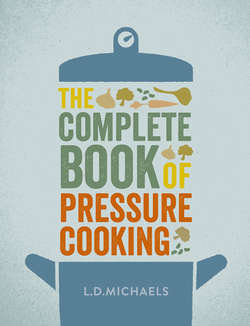Читать книгу The Complete Book of Pressure Cooking - L.D. Michaels - Страница 9
THE PHYSICS OF PRESSURE COOKING
ОглавлениеNow more specifically on to the “science” bit. The temperature at which water becomes steam depends on the pressure of the surrounding air. The higher the pressure, the higher the temperature at which the water boils. Conversely, several hundred metres up a mountain, water will boil below 100°C (212°F).
Water in an open pan at sea level (15 psi or less familiarly 101.325kg/m2 or 1 bar) boils normally. Close the pan, let the air escape and the steam builds up pressure inside, just like a steam engine. By letting a little of the steam at a time out of the pan, you can control the pressure inside. Normally this is done by means of weights or a spring-loaded valve and usually the pressure is kept at twice atmospheric pressure. Most pressure cookbooks call this 15 psi. Under these conditions, the boiling point of water becomes 121°C (250°F) and the cooking is achieved by means of higher heat and a forced “injection” of steam, which sounds more horrific than it actually is.
This “standard” pressure is, however, no longer much observed and many pressure cookers only reach 12 psi. There are a few, mostly for the catering industry, that reach 20 psi. In addition, many pressure cookers enable you to lower the internal pressure somewhat by using different weights or adjusting a valve. Most models give you a choice of high and low pressure, but a few give you three levels: High, Medium and Low.
The table shows the impact of pressure on cooking temperature. I have also shown cooking time adjustments for the most common pressures, but for the others it is best to check with the manufacturer’s handbook – look for common items such as potatoes and meat and compare them with the timings in this book.
| Psi | Bar / Atmosphere | kPA (KiloPascal) | °C | °F | Cooking Time Adjustment |
| 20 | 1.33 | 138 | 126 | 259 | Check manufacturer’s tables |
| Normal pressures | |||||
| 15 | 1 | 103 | 121 | 250 | none |
| 12 | 0.8 | 83 | 117 | 242 | 120% |
| 10 | 0.67 | 69 | 113 | 235 | 130% |
| Lower pressures | |||||
| 8 | 0.53 | 55 | 110 | 230 | Check manufacturer’s tables |
| 7 | 0.46 | 48 | 109 | 228 | Check manufacturer’s tables |
| 5 | 0.33 | 34 | 106 | 228 | Check manufacturer’s tables |
Most “ordinary” cooking, when broken down and subjected to the question “what is actually going on in there?”, turns out to be fairly complicated. We just do certain things by instinct, and that’s the way it will happen for you with pressure cooking.
